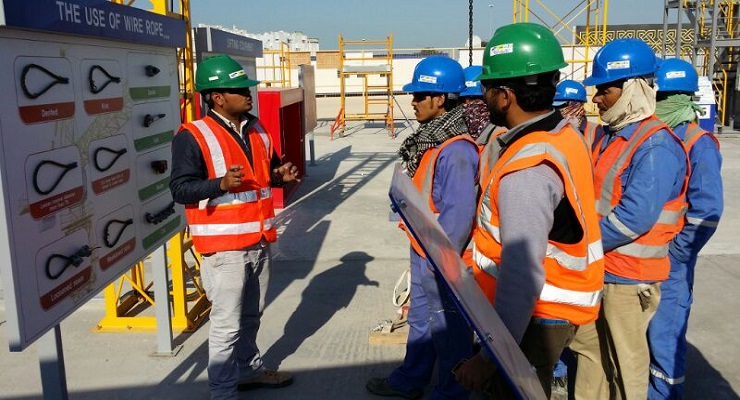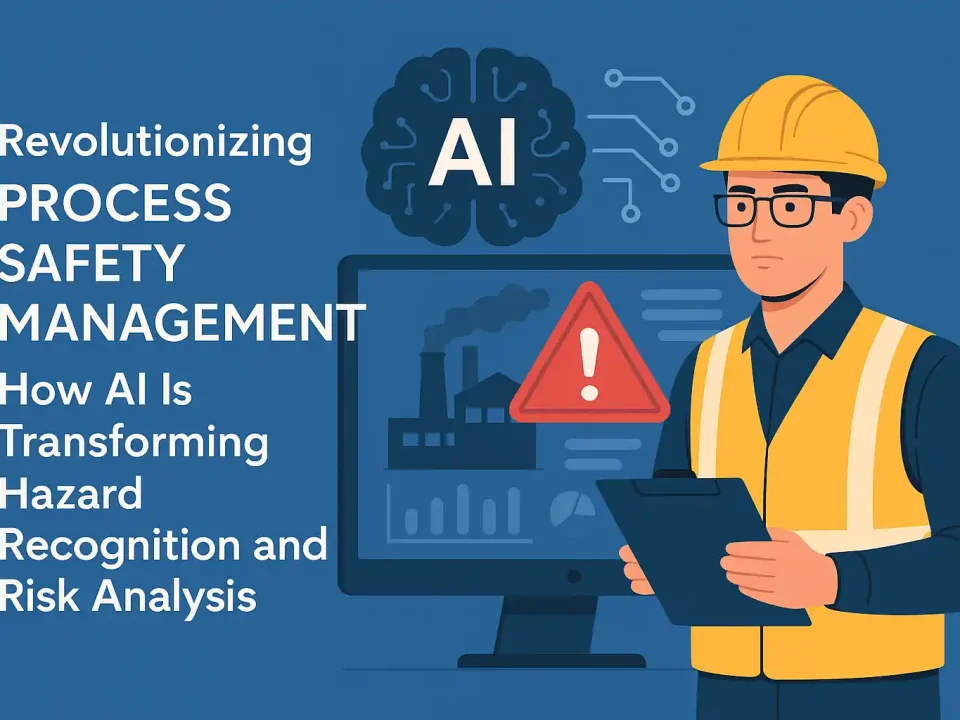14 Elements of Process Safety Management: A Comprehensive Guide to the PSM System

How to Calculate Fire Load: Formula, Method, and Importance Explained
July 4, 2025
The Role of Technology in Modern Fire Safety Audits
July 11, 2025Introduction
Process Safety Management is a structured framework designed to prevent the release of hazardous chemicals and manage risks in industries dealing with high-risk operations. It is especially critical in sectors such as oil and gas, chemicals, pharmaceuticals, and manufacturing, where even a minor failure can lead to catastrophic consequences.
Identifying and mitigating risks in these hazardous environments is not just about regulatory compliance—it’s a fundamental aspect of protecting lives, property, and the environment. Without a robust system in place, organizations are vulnerable to incidents that can cause widespread harm and financial loss.
To address this need, the Occupational Safety and Health Administration (OSHA) developed a comprehensive guideline comprising 14 core process safety management elements. These elements form the backbone of a proactive safety system, ensuring all aspects of process safety—from hazard analysis to emergency response—are properly managed.
In the following sections, we’ll explore each of these 14 elements in detail and understand how they contribute to a safer, more controlled industrial environment.
What Are PSM Elements?
PSM elements refer to the core components outlined in the Process Safety Management system that work together to identify, evaluate, and control hazards associated with processes involving highly hazardous chemicals. These elements are not isolated procedures but interconnected safety practices designed to strengthen the overall safety architecture of industrial operations.
Each element addresses a specific aspect of process safety, from gathering technical information to managing change, maintaining equipment, and investigating incidents. Together, they provide a structured and holistic approach to minimize the risk of accidents that can result in injury, environmental damage, or costly downtime.
The importance of PSM elements lies in their ability to create a culture of safety and accountability across all levels of an organization. By consistently applying these elements, industries can prevent catastrophic failures, ensure regulatory compliance, and foster continuous improvement in their safety performance.
In the next section, we’ll delve into the 14 elements of process safety management and explain the role each one plays in maintaining operational integrity.
The 14 Elements of Process Safety Management
The 14 elements of process safety management provide a structured framework for managing chemical process risks in industries where hazardous materials are present. These elements are designed to prevent incidents and ensure operational continuity through proactive hazard control and regulatory compliance.
1. Process Safety Information (PSI)
This involves gathering detailed information about hazardous chemicals, equipment specifications, and process technology. PSI lays the groundwork for informed decision-making during hazard assessments like a Hazop Study. It ensures that all safety evaluations are based on accurate, up-to-date technical data.
2. Process Hazard Analysis (PHA)
PHA systematically identifies potential hazards using tools like What-If, FMEA, or HAZOP. It’s a critical step in recognizing risks that could lead to catastrophic events. Conducted regularly, this analysis enables teams to develop control measures to eliminate or mitigate identified hazards.
3. Operating Procedures
Clear and well-documented procedures for startup, shutdown, normal operation, and emergencies are essential. They ensure consistency and safety across shifts. Employees must be trained to follow these procedures precisely, especially when dealing with hazardous chemicals or complex equipment.
4. Training
Effective training ensures employees understand their roles, operational procedures, and emergency protocols. Training is especially vital for new hires and when introducing new processes. Continuous training helps reinforce safety awareness and keeps employees updated on regulatory changes.
5. Mechanical Integrity
Mechanical integrity focuses on maintaining critical process equipment such as vessels, piping, and control systems. Regular inspections, testing, and maintenance ensure reliability. When mechanical integrity is overlooked, the risk of failures, leaks, or explosions significantly increases.
6. Management of Change (MOC)
MOC ensures that any change to equipment, chemicals, or procedures is evaluated for safety risks before implementation. Even seemingly minor changes can introduce new hazards. This element formalizes the review and approval process to maintain safe operations.
7. Pre-Startup Safety Review (PSSR)
Before starting a new or modified system, a thorough safety check is required. The PSSR ensures all construction is complete, PSI is updated, employees are trained, and equipment is tested. This step prevents unexpected failures during startup.
8. Emergency Planning and Response
A well-developed emergency plan prepares facilities to respond to fires, chemical releases, or natural disasters. It includes alarms, evacuation procedures, and coordination with local emergency services. A thorough Fire Audit can help identify gaps in readiness.
9. Contractor Safety
Contractors working on-site must adhere to the same safety standards as employees. This element ensures they are trained, informed about hazards, and monitored. Pre-qualification, job safety analysis, and safety briefings are integral to managing contractor risks.
10. Employee Participation
Engaging employees in safety programs enhances compliance and fosters a culture of accountability. Workers often have firsthand knowledge of risks and can contribute valuable insights. Participation may include involvement in PHAs, incident investigations, and procedure reviews.
11. Incident Investigation
All incidents, including near-misses, must be thoroughly investigated to determine root causes. Timely investigations help prevent recurrence. Recommendations from findings should be implemented and tracked. This also helps during a Safety Audit by demonstrating proactive risk management.
12. Compliance Audits
Facilities must conduct regular audits to ensure adherence to all PSM elements. Audits identify gaps and opportunities for improvement. An external Safety Consultant can offer an unbiased evaluation and expert recommendations to close safety gaps.
13. Trade Secrets
While companies may have proprietary processes or chemicals, trade secrets must not hinder safety transparency. Information relevant to employee safety must be accessible for training, analysis, and emergency planning, even if confidentiality needs to be maintained.
14. Hot Work Permit
Hot work (like welding or cutting) in hazardous areas must be strictly controlled. A formal permit system ensures that fire prevention measures are in place. This reduces the likelihood of fire or explosion in areas with flammable substances.
Why These 14 Elements of PSM Matter
The 14 elements of PSM serve as the foundation for building a strong safety culture in any high-risk industry. Each element addresses a critical aspect of operational integrity—whether it’s ensuring equipment reliability, managing organizational changes, or preparing for emergencies. When applied systematically, these elements significantly reduce the risk of chemical releases, fires, explosions, and other potentially catastrophic incidents.
By focusing on prevention, the 14 elements of PSM help organizations maintain regulatory compliance, minimize downtime, and protect both workers and the environment. They transform reactive safety practices into proactive ones, reducing both the likelihood and severity of process-related accidents.
Real-World Importance of Process Safety Elements
The true value of process safety elements is evident when looking at real-world industrial accidents. Incidents such as the 1984 Bhopal gas tragedy or the 2005 Texas City refinery explosion were directly linked to failures in process hazard analysis, poor maintenance, or inadequate emergency response planning—key components of PSM.
In contrast, companies that rigorously follow process safety elements often prevent minor issues from escalating into major disasters. For example, firms that conduct regular Management of Change (MOC) reviews or Pre-Startup Safety Reviews (PSSR) frequently catch safety gaps before they lead to incidents. These examples highlight that investing in PSM isn’t just a compliance requirement—it’s a critical operational strategy.
Final Thoughts on Process Safety Management Elements
Understanding and implementing process safety management elements is not just about ticking boxes for regulatory compliance—it’s about fostering a culture of safety and responsibility across all levels of an organization. These elements are interconnected and work together to build a resilient system that can anticipate, withstand, and recover from hazardous events.
Compliance with these standards must be an ongoing commitment. As technologies evolve and processes become more complex, so too must the safety strategies that govern them. Regular reviews, employee engagement, and continuous training are key to maintaining the effectiveness of your PSM program. By embedding these principles into daily operations, organizations not only ensure compliance but also build a safer, more sustainable future.
FAQs
What are the elements of process safety?
The elements of process safety refer to the foundational components designed to manage hazards associated with industrial processes involving hazardous chemicals. These include Process Safety Information, Hazard Analysis, Operating Procedures, Training, Mechanical Integrity, Management of Change, Incident Investigation, and Emergency Planning, among others. These process safety elements help organizations identify risks, implement controls, and ensure safe operations. They form the backbone of regulatory frameworks like OSHA’s PSM standard and are essential for accident prevention, environmental protection, and safeguarding employees and assets in high-risk industries like oil, gas, and chemicals.
What are the elements of safety management system?
A Safety Management System (SMS) comprises structured processes and policies that ensure workplace safety through proactive risk management. Its core elements include Safety Policy, Risk Assessment, Safety Assurance, Safety Promotion (training and communication), Emergency Response Planning, Documentation, and Continuous Improvement. These components foster a safety culture, helping organizations meet regulatory standards, reduce incidents, and enhance operational reliability. Unlike process safety systems that focus on technical hazards, SMS covers broader occupational health and safety issues, integrating both human and system-based approaches. Effective SMS implementation ensures all employees are aligned with safety goals and responsibilities.
How many elements are there in PSM?
There are 14 elements in PSM (Process Safety Management) as defined by OSHA’s standard for handling highly hazardous chemicals. These elements include Process Safety Information, Process Hazard Analysis, Operating Procedures, Training, Mechanical Integrity, Management of Change, Pre-Startup Safety Review, Emergency Planning and Response, Contractor Safety, Employee Participation, Incident Investigation, Compliance Audits, Trade Secrets, and Hot Work Permit. Each of these elements is interconnected and essential for building a safe, compliant, and efficient industrial environment. Together, they form a comprehensive framework to prevent catastrophic chemical releases and enhance overall process reliability.
How many steps are in PSM?
PSM typically consists of 14 core steps or elements, as established by OSHA under 29 CFR 1910.119. These steps guide organizations in the safe design, operation, and maintenance of processes involving hazardous chemicals. Each step—such as conducting a Hazop Study, ensuring Mechanical Integrity, or performing a Safety Audit—contributes to identifying and mitigating risks. While the terminology may vary, the framework remains consistent across industries, focusing on prevention, preparedness, and response. A well-executed PSM program incorporates all 14 steps into daily operations to achieve continuous safety improvement.




